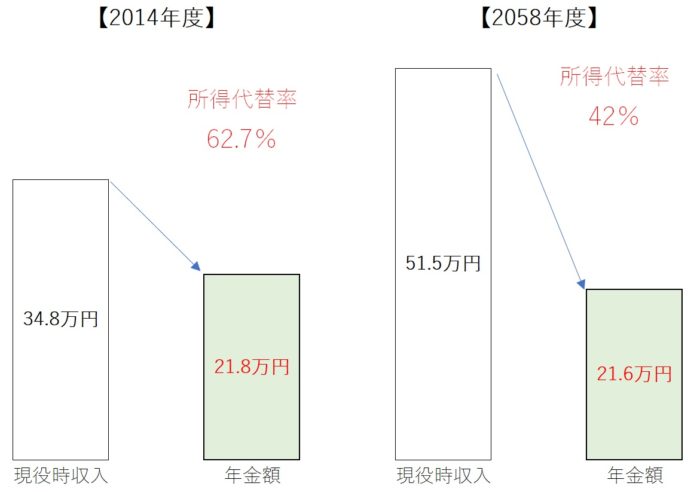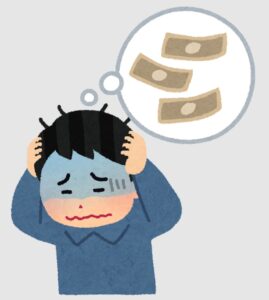管理人オススメコンテンツはこちら
「受給額はそこまで減らない|年金ショック?数字のトリックにご用心!」
〜前回のつづき〜
●年金が2〜3割も減るかもしれないのに悲観的にならなくてもいい3つの理由
理由(1)
所得代替率は2〜3割減るが受給額はそこまで減らないから
減少するのは
あくまでも
所得代替率です。

(出典:https://kobito-kabu.com/nenkin-sukunakunaru/)
受給額が
どうなるかというのは
その時の
現役時の収入水準による訳ですね。
今は
現役時の収入が34.8万円なので
所得代替率が62.7%で
受け取れる年金額が
21.8万円。
将来的に
2058年度には
現役時の収入は
51.5万円ぐらいに上がってて
所得代替率は下がってて
42%になってるんだけど
もらえる年金額は
21.6万円という
何だか
ピンと来ない話ですよね?
実質賃金上昇率というのを
1%とした場合
40年後には
手取り収入が34.8万円から
51.5万円に増加してる事に
なりますよね?
だから
所得代替率が
62.7%から42%に減っても
受給額そのものは
21.6万円と
あまり減ってないという
事になります。
すごく
不思議な感じがしますよね?
感覚的には
正直なところ
ピンと来ない所は
大いに有ると思うんですよ。
有ると思うんですけど
あくまでデータ上は
ちょっと減るだけだ
という事なんですね。
ちなみに
所得代替率というのは
50%を切らないように
調整する事になってるので
ひたすら
この所得代替率が
下がり続けるというのは
割と
保守的な見方なんですよね。
参考書籍についてなんですけど
今お話しした考え方とか
数値というのは

(出典:Amazon)
この本に
書かれてるんですね。
年金制度について
非常にわかりやすく
そして網羅的にまとめられてる
非常にいい本だと思うので
年金制度に興味が有るのであれば
ぜひ読んでみて欲しいと思います。
ここまでのお話しを読んで
年金制度に不安が有る人は
「え!?実質賃金上昇率1%?
そんなペースで給料増えてないよ!」
とか
「確かに1%ずつ上昇していけば
理屈上はそうなるかもしれないけど
別に賃金毎年1%なんて伸びてないよ!」
とか
「これから先だって
増える見込みなんて
無いじゃないか!」
とか
そういう意見って
有ると思うんですね。
でも
このシミュレーションは
政府が作った8つのシナリオのうち
下から2番目の
シナリオに
基づいてるんですね。
比較的保守的な
経済的成長が弱いという
シナリオという事なんですね。
なので
想定通りに行くかどうか
というのは置いといて
政府は色んなシナリオを考えて
年金財政を一応検証してるんですね。
だからこの事は
知っておいていいと思います。
という事で
これが理由の1つ目になってきます。
〜〜〜つづく〜〜〜
Special Thanks college president Ryo.
●おまけ
≪≪perplexityちゃんによる文章まとめ≫≫
年金が将来2〜3割減るといわれるのは「所得代替率」の低下を指しており、実際の受給額が大きく減るわけではありません。
例えば現状では、現役時収入34.8万円・所得代替率62.7%で21.8万円受給。2058年度には収入51.5万円・所得代替率42%ですが、受給額は21.6万円とほぼ同水準です。
これは実質賃金が年1%程度伸びるという保守的な政府シナリオを前提としており、賃金上昇に合わせて年金額も調整されるためです。
さらに制度上、所得代替率は50%を下回らないよう設計されています。
この試算は政府が提示する8パターン中、下から2番目の経済成長率の低いケースに基づくもので、悲観的な見通しにも対応しています。
つまり、率は下がっても額は大きく減らない可能性が高いということです。
- https://www.mhlw.go.jp/nenkinkenshou/manga/09.html
- https://www.smtb.jp/personal/saving/pension/dc-column/column-12
- https://www.dlri.co.jp/report/ld/271001.html
- https://www.nikkei.com/article/DGXZQOUA025JS0S4A700C2000000/
- https://www.mhlw.go.jp/nenkinkenshou/manga/10.html
- https://www.dir.co.jp/report/research/policy-analysis/social-securities/20240627_024468.html
- https://www.tr.mufg.jp/houjin/jutaku/yougo_kensaku/kaisetsu/ja_si/ja_si_016.html
- https://www.am-one.co.jp/hagukumu/article/column-20240731-1.html
- https://ideco.kddi-am.com/learn/column/ideco0098/
≪≪Chat-GPTくんによる英訳≫≫
~Continuation from last time~
Three reasons not to be overly pessimistic even if pensions might drop by 20–30%
Reason (1)
Because while the income replacement rate may drop by 20–30%, the actual benefits won’t decrease nearly as much.
What’s decreasing is only the income replacement rate.
(Source: [https://kobito-kabu.com/nenkin-sukunakunaru/](https://kobito-kabu.com/nenkin-sukunakunaru/))
How much you actually receive in pension benefits depends on the income level you had during your working years at that time.
Currently, the average monthly income for working people is ¥348,000, and the income replacement rate is 62.7%.
That means the pension benefits you can receive are ¥218,000.
In the future, in fiscal year 2058,
the average monthly income for working people is expected to rise to around ¥515,000.
The income replacement rate will drop to 42%,
but the pension benefits will still be ¥216,000.
It sounds a bit counterintuitive, doesn’t it?
If we assume a real wage growth rate of 1%,
then 40 years from now,
take-home pay will increase from ¥348,000 to ¥515,000.
So even if the income replacement rate drops from 62.7% to 42%,
the actual benefit amount will still be ¥216,000,
which means it won’t decrease much at all.
It feels a little strange, right?
Honestly, I think many people find it hard to get a clear sense of this.
But according to the data,
it only drops a little.
Incidentally, the income replacement rate is supposed to be adjusted so it never falls below 50%,
so assuming that it will just keep declining endlessly is actually a fairly conservative outlook.
Regarding reference books—
the ideas and figures I just mentioned are taken from this book:
(Source: Amazon)
It’s a very good book that explains the pension system clearly and comprehensively.
If you’re interested in the pension system, I highly recommend reading it.
Now, after reading up to this point, those who feel uneasy about the pension system might say:
> “What? A real wage growth rate of 1%?
> My salary hasn’t been increasing at that pace!”
> “Sure, if it increases by 1% each year, then in theory that’s how it works,
> but wages haven’t been going up 1% every year!”
Or:
> “There’s no prospect that it will increase in the future either!”
I understand such opinions.
However, this simulation is based on the second-lowest of the eight scenarios created by the government.
It’s a scenario assuming relatively conservative economic growth.
So, whether things go exactly as assumed is another matter,
but the government does consider various scenarios and evaluates the pension finances accordingly.
I think it’s good to know this.
And that’s the first reason.
Special Thanks OpenAI and Perplexity AI, Inc








-300x300.jpg)